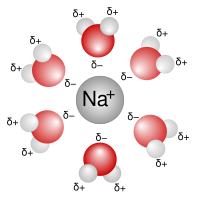
Photo from wikipedia
This chapter describes an experimental method to quantitatively evaluate the solubility of proteins in aqueous solutions. Measurement of protein solubility can be challenging because low solubility can be manifested through… Click to show full abstract
This chapter describes an experimental method to quantitatively evaluate the solubility of proteins in aqueous solutions. Measurement of protein solubility can be challenging because low solubility can be manifested through various pathways (e.g., crystallization, aggregation, gelation, and liquid-liquid phase separation), some of which may occur over long periods of time. In the method described here, a nonionic polymer, polyethylene glycol (PEG), is added to a protein solution of interest to induce instantaneous formation of protein-rich liquid droplets. After incubation at a given temperature, the samples are centrifuged. The protein concentration in the supernatant is measured at various PEG concentrations to calculate an equilibrium binding free energy, which provides a measure of protein solubility. Based on the first principles of thermodynamics, this method is highly reproducible and applicable to various proteins and buffer conditions.
Journal Title: Methods in molecular biology
Year Published: 2019
Link to full text (if available)
Share on Social Media: Sign Up to like & get
recommendations!